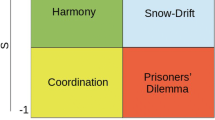Abstract
Evolutionary game theory is an increasingly important way to model the evolution of biological populations. Many early models were in the form of matrix games, or bi-matrix games in asymmetric situations when individuals occupy distinct roles within the contest, where rewards are accrued through independent contests against random members of the population. More recent models have not had the simple linear properties of matrix games, and more general analysis has been required. In this paper we carry out a general analysis of asymmetric games, comparing monomorphic and polymorphic populations. We are particularly interested in situations where the strategies that individuals play influence which role that they occupy, for example in a more realistic variant of the classical Owner-Intruder game. We both prove general results and consider specific examples to illustrate the difficulties of these more complex games.
Similar content being viewed by others
References
Argasinski K (2006) Dynamic multipopulation and density dependent evolutionary games related to replicator dynamics. A metasimplex concept. Math Biosci 202(1):88–114
Bishop D, Cannings C (1976) Models of animal conflict. Adv Appl Probl 8:616–621
Broom M, Rychtář J (2013) Game-theoretical models in biology. CRC, Chapman and Hall
Broom M, Luther R, Ruxton G (2004) Resistance is useless? Extensions to the game theory of kleptoparasitism. Bull Math Biol 66(6):1645–1658
Broom M, Luther R, Ruxton G, Rychtář J (2008) A game-theoretic model of kleptoparasitic behavior in polymorphic populations. J Theor Biol 255(1):81–91
Cressman R (2003) Evolutionary dynamics and extensive form games. MIT, Cambridge
Fisher R (1930) The genetical theory of natural selection. Clarendon, Oxford
Hamilton W (1964) The genetical evolution of social behaviour. I and II. J Theor Biol 7(1):17–52
Hamilton W (1967) Extraordinary sex ratios. Science 156:477–488
Hofbauer J, Sigmund K (1998) Evolutionary games and population dynamics. Cambridge University Press, Cambridge
Kokko H, Johnstone RA (2002) Why is mutual mate choice not the norm? Operational sex ratios, sex roles and the evolution of sexually dimorphic and monomorphic signalling. Philos Trans R Soc Lond B 357(1419):319–330
Maynard Smith J (1982) Evolution and the theory of games. Cambridge University Press, Cambridge
Maynard Smith J, Parker G (1976) The logic of asymmetric contests. Anim Behav 24:159–175
Maynard Smith J, Price G (1973) The logic of animal conflict. Nature 246:15–18
Parker G (1978) Searching for mates. In: Krebbs JR, Davies NB, eds. Behavioural ecology: an evolutionary approach, pp 214–244
Sandholm W (2010) Population games and evolutionary dynamics. MIT, Cambridge
Schuster P, Sigmund K (1981) Coyness, philandering and stable strategies. Anim Behav 29(1):186–192
Selten R (1980) A note on evolutionarily stable strategies in asymmetric animal conflicts. J Theor Biol 84:93–101
Taylor C, Nowak M (2006) Evolutionary game dynamics with non-uniform interaction rates. Theor Popul Biol 69(3):243–252
Taylor P, Jonker L (1978) Evolutionarily stable strategies and game dynamics. Math Biosci 40:145–156
Trivers R (1971) The evolution of reciprocal altruism. Q Rev Biol 46(1):35–57
Acknowledgments
The research was supported by Simons Foundation grant 245400. We would also like to thank the reviewers whose comments helped to improve the clarity of the manuscript. This paper was handled by the Editor-in-Chief.
Author information
Authors and Affiliations
Corresponding author
Rights and permissions
About this article
Cite this article
Broom, M., Rychtář, J. Asymmetric Games in Monomorphic and Polymorphic Populations. Dyn Games Appl 4, 391–406 (2014). https://doi.org/10.1007/s13235-014-0112-4
Published:
Issue Date:
DOI: https://doi.org/10.1007/s13235-014-0112-4




